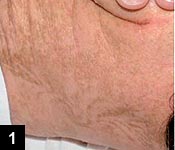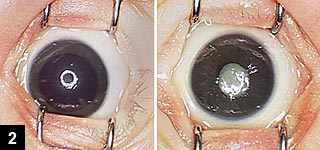Congenital cataract seen in infant with short limbs, ichthyosis
The left eye featured poor pupillary dilation and a dense cataract.
 Jeffrey Chang |  Vivek Chaturvedi | ||
A 3-day-old infant was seen by the pediatric ophthalmology service for suspicion of congenital cataracts. The infant was a 39-week gestation girl born to a 31-year-old woman with unremarkable prenatal labs. The mother’s pregnancy was complicated by a prenatal ultrasound at 33 weeks showing short long bones. Subsequent amniocentesis showed normal chromosomes of 46-XX. Both the mother and aunt have a history of variable ichthyosis.
Examination
On examination, the patient’s birth weight was 2,992 g. She had mild biparietal cranial widening and an open fontanelle. Her nasal bridge was flat with a hemangioma in the middle of her forehead. Her neck, legs and arms appeared short, with the left leg shorter than right. There was diffuse ichthyosis covering her entire body except for the face and genitalia, and the ichthyosis was found to be in a spiral-like pattern on the abdomen and back (Figure 1).
 Prominent, thick, keratinized skin plaques distributed in a whorled pattern. |
 Left eye demonstrates poor pupillary dilation and dense cataract. Images: Chen J, Strominger MB |
|
On ophthalmic examination, there was poor pupillary dilation of the left eye as well as a dense cataract in the left eye (Figure 2). The patient’s corneas were clear, and her pupils were reactive bilaterally. Her anterior chambers appeared normal. The fundus was unremarkable on the right, and a B-scan showed no vitreoretinal abnormalities in the left eye.

What is your diagnosis?
Unilateral congenital cataracts
The diagnosis of unilateral congenital cataracts typically includes idiopathic etiologies, persistent fetal vasculature, anterior segment dysgenesis, posterior lenticonus, posterior pole tumors, trauma, rubella or masked bilateral cataracts. However, this patient had findings suggestive of a hereditary etiology, which initially prompted the ophthalmic consultation, and further tests were done.
A skeletal survey was performed and revealed diffuse stippling of the epiphyses of the long bones as well as the vertebral bodies and sternum, signifying abnormal calcification in those areas (Figure 3). In addition, the patient’s left femur and humerus were both shorter than their right counterparts. A blood cholestanol revealed mildly increased levels of 8(9)-cholestanol, suggesting a diagnosis of sterol delta 8 isomerase deficiency. The combination of stippled epiphyses, skin findings, cataract and increased blood cholestanol confirmed the diagnosis of Conradi’s syndrome of the X-linked dominant type.
Discussion
First described in 1914, Conradi’s syndrome is characterized by deposition of calcium salts in regions of enchondral ossifications centers, causing stippling of epiphyses and extraepiphyseal cartilages. The incidence is approximately one in 500,000 births.
There are three genetic subtypes of Conradi’s syndrome: the lethal, autosomal recessive rhizomelic type; the mild, heterogeneous, autosomal dominant type; and the X-linked dominant type, which occurs almost exclusively in female patients.
Each of the three genetic types has unique manifestations with regard to the degree of bone abnormalities as well as skin, vascular and nervous system findings. However, all three can share systemic manifestations such as short necks, frontal bossing, saddle noses, high arched palates and hypertelorism.
The X-linked dominant type, which this patient had, presents with milder asymmetric shortening of long bones. The X-linked dominant form is associated with mutations in the emopamil binding protein gene, causing a deficiency in an enzyme that catalyzes a step in cholesterol biosynthesis. Vascular and neuronal defects are absent, and life expectancy is typically normal unless there are heart and lung function abnormalities as a result of scoliosis. Patients will classically present with a congenital ichthyosis described as keratinized plaques in a linear or swirl pattern over the entire body, which disappear in the first few weeks of life. Patients may also have patchy alopecia, sparse eyebrows and flattened nail plates.
The autosomal recessive rhizomelic type is lethal; patients typically die within the first few years of life. Their survival is correlated with the extent of the heart and lung defects. There is prominent proximal shortening of extremities, vascular abnormalities and neuronal atrophy with severe retardation. In contrast, the mild autosomal dominant type presents predominantly with epiphyseal calcifications. There are no skin, neural or vascular findings, and life expectancy is normal.
A variety of ocular manifestations are seen in the autosomal recessive rhizomelic form. More than two-thirds of these patients will present with bilateral cataracts. Optic atrophy, microphthalmos, iris hypoplasia, Axenfeld-Reiger syndrome and bilateral corneal punctate erosions are also seen. Cataracts appear to be the only ocular manifestation of the X-linked dominant form; they are usually bilateral but asymmetric. The asymmetry is likely due to inactivation of an X chromosome. No cataracts have been reported in the mild, autosomal dominant type, thus prompting the suggestion that cataracts be used as another diagnostic marker to differentiate between the three types of this disease.
Conradi’s syndrome is a hereditary disease that can affect multiple organ systems. Despite its rarity, the ocular and systemic manifestations are worthwhile to know for the ophthalmologist, as the eye findings may call attention to other potential defects associated with this disease. Conradi’s syndrome should be considered in the differential diagnosis when congenital cataracts are seen in a newborn.
References:
- Ausavarat S, Tanpaiboon P, Tongkobpetch S, Suphapeetiporn K, Shotelersuk V. Two novel EBP mutations in Conradi-Hünermann-Happle syndrome. Eur J Dermatol. 2008;18(4):391-393.
- Massey JY, Roy FH. Ocular manifestations of Conradi disease. Arch Ophthalmol. 1974;92(6):524-526.
- Mintz-Hittner H, Kretzer FL. Conradi’s Syndrome. In: Gold D, Weingeist T, eds. The Eye in Systemic Disease. Philadelphia: J.B. Lippincott; 1990:137-142.
- Levine RE, Snyder AA, Sugarman GI. Ocular involvement in chondrodysplasia punctata. Am J Ophthalmol. 1974;77(6):851-859.
- Hammond A. Dysplasia epiphysialis punctata with ocular anomalies. Br J Ophthalmol. 1970;54(11):755-758.
- Ryan H. Cataracts of dysplasia epiphysialis punctata. Br J Ophthalmol. 1970;54(3):197-199.
- John Chen, MD, and Mitchell B. Strominger, MD, can be reached at New England Eye Center, Tufts University School of Medicine, 750 Washington St., Box 450, Boston, MA 02111; 617-636-4219; fax: 617-636-4866; Web site: www.neec.com.
- Edited by Jeffrey Chang, MD, and Vivek Chaturvedi, MD. Drs. Chang and Chaturvedi can be reached at New England Eye Center, Tufts University School of Medicine, 750 Washington St., Box 450, Boston, MA 02111; 617-636-4219; fax: 617-636-4866; Web site: www.neec.com.

